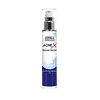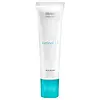What's inside
What's inside
 Key Ingredients
Key Ingredients

 Benefits
Benefits

 Concerns
Concerns

 Ingredients Side-by-side
Ingredients Side-by-side

Water
Skin ConditioningGlycerin
HumectantPropylene Glycol
HumectantCaprylic/Capric Triglyceride
MaskingHydrogenated Phosphatidylcholine
EmulsifyingAlcohol
AntimicrobialRetinol
Skin ConditioningMacadamia Ternifolia Seed Oil
EmollientBrassica Campestris Sterols
EmollientPEG-5 Rapeseed Sterol
CleansingCeteth-3
EmulsifyingCeteth-5
EmulsifyingCholesterol
EmollientSilica
AbrasiveSodium Ascorbyl Phosphate
AntioxidantCetyl Phosphate
Emulsifying1,2-Hexanediol
Skin ConditioningPolysorbate 20
EmulsifyingDisodium EDTA
Paraffinum Liquidum
EmollientButylene Glycol
HumectantNeopentyl Glycol Dicaprate
EmollientPhenyl Trimethicone
Skin ConditioningOctyldodecyl Stearoyl Stearate
EmollientHexyl Laurate
Emollient3-O-Ethyl Ascorbic Acid
Skin ConditioningHydrogenated Lecithin
EmulsifyingPolyglyceryl-3 Methylglucose Distearate
EmulsifyingTocopheryl Acetate
AntioxidantCentella Asiatica Extract
CleansingEthylhexylglycerin
Skin ConditioningDimethicone
EmollientPEG-100 Stearate
Glyceryl Stearate
EmollientDipropylene Glycol
HumectantCetyl Alcohol
EmollientSodium Hyaluronate
HumectantTriethanolamine
BufferingSalicylic Acid
MaskingPhenoxyethanol
PreservativeCarbomer
Emulsion StabilisingStearic Acid
CleansingCera Alba
EmollientBHT
AntioxidantParfum
MaskingWater, Glycerin, Propylene Glycol, Caprylic/Capric Triglyceride, Hydrogenated Phosphatidylcholine, Alcohol, Retinol, Macadamia Ternifolia Seed Oil, Brassica Campestris Sterols, PEG-5 Rapeseed Sterol, Ceteth-3, Ceteth-5, Cholesterol, Silica, Sodium Ascorbyl Phosphate, Cetyl Phosphate, 1,2-Hexanediol, Polysorbate 20, Disodium EDTA, Paraffinum Liquidum, Butylene Glycol, Neopentyl Glycol Dicaprate, Phenyl Trimethicone, Octyldodecyl Stearoyl Stearate, Hexyl Laurate, 3-O-Ethyl Ascorbic Acid, Hydrogenated Lecithin, Polyglyceryl-3 Methylglucose Distearate, Tocopheryl Acetate, Centella Asiatica Extract, Ethylhexylglycerin, Dimethicone, PEG-100 Stearate, Glyceryl Stearate, Dipropylene Glycol, Cetyl Alcohol, Sodium Hyaluronate, Triethanolamine, Salicylic Acid, Phenoxyethanol, Carbomer, Stearic Acid, Cera Alba, BHT, Parfum
Water
Skin ConditioningCaprylic/Capric Triglyceride
MaskingGlyceryl Stearate
EmollientCyclopentasiloxane
EmollientButylene Glycol
HumectantStearic Acid
CleansingButyrospermum Parkii Butter
Skin ConditioningPolysorbate 60
EmulsifyingStearyl Alcohol
EmollientGlycerin
HumectantAllyl Methacrylates Crosspolymer
Emulsion StabilisingRetinol
Skin ConditioningPolysorbate 20
EmulsifyingDimethicone
EmollientSimmondsia Chinensis Seed Oil
EmollientChamomilla Recutita Flower Extract
MaskingHypericum Perforatum Flower Extract
Skin ConditioningMalva Sylvestris Flower Extract
Skin ConditioningSalvia Officinalis Leaf Extract
CleansingSambucus Nigra Flower Extract
RefreshingCyclohexasiloxane
EmollientSorbitol
HumectantTocopheryl Acetate
AntioxidantAscorbic Acid
AntioxidantUbiquinone
AntioxidantSodium Hyaluronate
HumectantPropylene Glycol
HumectantBHT
AntioxidantBisabolol
MaskingDimethicone/Vinyl Dimethicone Crosspolymer
Skin ConditioningDipotassium Glycyrrhizate
HumectantDisodium EDTA
Triethanolamine
BufferingCarbomer
Emulsion StabilisingGlyceryl Acrylate/Acrylic Acid Copolymer
HumectantCaprylyl Glycol
EmollientEthylhexylglycerin
Skin ConditioningHexylene Glycol
EmulsifyingPhenoxyethanol
PreservativeWater, Caprylic/Capric Triglyceride, Glyceryl Stearate, Cyclopentasiloxane, Butylene Glycol, Stearic Acid, Butyrospermum Parkii Butter, Polysorbate 60, Stearyl Alcohol, Glycerin, Allyl Methacrylates Crosspolymer, Retinol, Polysorbate 20, Dimethicone, Simmondsia Chinensis Seed Oil, Chamomilla Recutita Flower Extract, Hypericum Perforatum Flower Extract, Malva Sylvestris Flower Extract, Salvia Officinalis Leaf Extract, Sambucus Nigra Flower Extract, Cyclohexasiloxane, Sorbitol, Tocopheryl Acetate, Ascorbic Acid, Ubiquinone, Sodium Hyaluronate, Propylene Glycol, BHT, Bisabolol, Dimethicone/Vinyl Dimethicone Crosspolymer, Dipotassium Glycyrrhizate, Disodium EDTA, Triethanolamine, Carbomer, Glyceryl Acrylate/Acrylic Acid Copolymer, Caprylyl Glycol, Ethylhexylglycerin, Hexylene Glycol, Phenoxyethanol
Ingredients Explained
These ingredients are found in both products.
Ingredients higher up in an ingredient list are typically present in a larger amount.
BHT is a synthetic antioxidant and preservative.
As an antioxidant, it helps your body fight off free-radicals. Free-radicals are molecules that may damage your skin cells.
As a preservative, it is used to stabilize products and prevent them from degrading. Specifically, BHT prevents degradation from oxidation.
The concerns related to BHT come from oral studies; this ingredient is currently allowed for use by both the FDA and EU.
However, it was recently restricted for use in the UK as of April 2024.
Learn more about BHTButylene Glycol (or BG) is used within cosmetic products for a few different reasons:
Overall, Butylene Glycol is a safe and well-rounded ingredient that works well with other ingredients.
Though this ingredient works well with most skin types, some people with sensitive skin may experience a reaction such as allergic rashes, closed comedones, or itchiness.
Learn more about Butylene GlycolThis ingredient is an emollient, solvent, and texture enhancer. It is considered a skin-softener by helping the skin prevent moisture loss.
It helps thicken a product's formula and makes it easier to spread by dissolving clumping compounds.
Caprylic Triglyceride is made by combining glycerin with coconut oil, forming a clear liquid.
While there is an assumption Caprylic Triglyceride can clog pores due to it being derived from coconut oil, there is no research supporting this.
Learn more about Caprylic/Capric TriglycerideCarbomer is a polymer of acrylic acid. Its main role is to create a gel consistency.
A high amount of carbomer can cause pilling or balling up of products. Don't worry, most products contain 1% or less of carbomer.
Dimethicone is a type of synthetic silicone created from natural materials such as quartz.
What it does:
Dimethicone comes in different viscosities:
Depending on the viscosity, dimethicone has different properties.
Ingredients lists don't always show which type is used, so we recommend reaching out to the brand if you have questions about the viscosity.
This ingredient is unlikely to cause irritation because it does not get absorbed into skin. However, people with silicone allergies should be careful about using this ingredient.
Note: Dimethicone may contribute to pilling. This is because it is not oil or water soluble, so pilling may occur when layered with products. When mixed with heavy oils in a formula, the outcome is also quite greasy.
Learn more about DimethiconeDisodium EDTA plays a role in making products more stable by aiding other preservatives.
It is a chelating agent, meaning it neutralizes metal ions that may be found in a product.
Disodium EDTA is a salt of edetic acid and is found to be safe in cosmetic ingredients.
Learn more about Disodium EDTAEthylhexylglycerin (we can't pronounce this either) is commonly used as a preservative and skin softener. It is derived from glyceryl.
You might see Ethylhexylglycerin often paired with other preservatives such as phenoxyethanol. Ethylhexylglycerin has been found to increase the effectiveness of these other preservatives.
Glycerin is already naturally found in your skin. It helps moisturize and protect your skin.
A study from 2016 found glycerin to be more effective as a humectant than AHAs and hyaluronic acid.
As a humectant, it helps the skin stay hydrated by pulling moisture to your skin. The low molecular weight of glycerin allows it to pull moisture into the deeper layers of your skin.
Hydrated skin improves your skin barrier; Your skin barrier helps protect against irritants and bacteria.
Glycerin has also been found to have antimicrobial and antiviral properties. Due to these properties, glycerin is often used in wound and burn treatments.
In cosmetics, glycerin is usually derived from plants such as soybean or palm. However, it can also be sourced from animals, such as tallow or animal fat.
This ingredient is organic, colorless, odorless, and non-toxic.
Glycerin is the name for this ingredient in American English. British English uses Glycerol/Glycerine.
Learn more about GlycerinGlyceryl Stearate is a mix of glycerin and stearic acid.
It is used to stabilize the mixing of water and oil ingredients. By preventing these ingredients from separating, it can help elongate shelf life. It can also help thicken the product's texture.
As an emollient, it helps soften skin and supports barrier-replenishing ingredients.
In cosmetics, Glyceryl Stearate is often made from vegetable oils or synthetically produced.
This ingredient may not be fungal-acne safe
Fun fact: The human body also creates Glyceryl Stearate naturally.
Learn more about Glyceryl StearatePhenoxyethanol is a preservative that has germicide, antimicrobial, and aromatic properties. Studies show that phenoxyethanol can prevent microbial growth. By itself, it has a scent that is similar to that of a rose.
It's often used in formulations along with Caprylyl Glycol to preserve the shelf life of products.
Polysorbate 20 is made by combining ethoxylation of sorbitan, ethylene oxide, and lauric acid. It is a mild cleansing agent, surfactant, and emulsifier.
As a surfactant, it helps collect dirt and oils for washing. Emulsifiers prevent oils and water from separating.
Polysorbate 20 also adds scent to a product. Since it is made using sorbitol, it has a sweet scent. Sorbitol can also be found in fruits such as apples and peaches.
The lauric acid used to create Polysorbate 20 is often derived from coconuts.
Polysorbate 20 may not be fungal acne safe.
Learn more about Polysorbate 20Propylene Glycol is an odorless, colorless liquid. As a humectant, it helps skin retain moisture. It also aids in delivering active ingredients.
Another role of this ingredient is preventing a product from melting or freezing. Propylene glycol also adds antimicrobrial properties to a product, elongating product lifespan.
This ingredient is considered an organic alcohol and commonly added into both cosmetics and foods.
Those with sensitive skin or conditions may develop a rash when using this ingredient.
Learn more about Propylene GlycolRetinol is a gold-standard ingredient for anti-aging. It is a form of Vitamin A and belongs to the class of retinoids that also includes tretinoin.
Why is retinol famous?
It has the most scientific studies backing up its skin benefits out of all the non-prescription ingredients.
Retinol is proven to:
This is why retinol is effective at removing wrinkles, fading dark spots, treating acne, and reducing the appearance of pores.
Studies show retinol is less effective when exposed to UV. Be sure to look for appropriate packaging to keep your retinol potent (similar to Vitamin C).
Using retinol or any retinoids will increase sun-sensitivity in the first few months. Though studies show retinoids increase your skin's natural SPF with continuous use, it is best to always wear sunscreen and sun-protection.
We recommend speaking with a medical professional about using this ingredient during pregnancy.
Retinol may cause irritation in some people, so be sure to patch test. Experts recommend 'ramping up' retinol use: start using this ingredient once a week and work up to using it daily.
Read about Tretinoin
Learn more about RetinolSodium Hyaluronate is hyaluronic acid's salt form. It is commonly derived from the sodium salt of hyaluronic acid.
Like hyaluronic acid, it is great at holding water and acts as a humectant. This makes it a great skin hydrating ingredient.
Sodium Hyaluronate is naturally occurring in our bodies and is mostly found in eye fluid and joints.
These are some other common types of Hyaluronic Acid:
Learn more about Sodium HyaluronateStearic Acid is a fatty acid. It is an emollient, emulsifier, and texture enhancer.
As an emollient, stearic acid helps soften skin. It aids the skin's protective barrier by preventing water loss. It also provides a gentle cleansing effect without stripping away natural oils.
Stearic acid may also be used to enhance the texture of products. It can add volume and stabilize ingredients such as water and oil. This can help water and oil ingredients from separating.
Sources of stearic acid include animal or vegetable fats/oils such as coconut or shea. It can be naturally found in butter, cocoa butter, shea butter, vegetable fats, and animal tallow.
This ingredient may not be Malassezia folliculitis, or fungal-acne safe.
Learn more about Stearic AcidTocopheryl Acetate is AKA Vitamin E. It is an antioxidant and protects your skin from free radicals. Free radicals damage the skin by breaking down collagen.
One study found using Tocopheryl Acetate with Vitamin C decreased the number of sunburned cells.
Tocopheryl Acetate is commonly found in both skincare and dietary supplements.
Learn more about Tocopheryl AcetateTriethanolamine is an emulsifier and pH adjuster. It is created using ethylene oxide and ammonia. This gives Triethanolamine a nitrogen core and a similar scent to ammonia.
As an emulsifier, it prevents ingredients from separating and enhances texture by adding volume to a product.
PH adjusters are common in cosmetic products. The pH of a product can affect the effectiveness of other ingredients. A product with a high pH may also irritate the skin.
Learn more about TriethanolamineWater. It's the most common cosmetic ingredient of all. You'll usually see it at the top of ingredient lists, meaning that it makes up the largest part of the product.
So why is it so popular? Water most often acts as a solvent - this means that it helps dissolve other ingredients into the formulation.
You'll also recognize water as that liquid we all need to stay alive. If you see this, drink a glass of water. Stay hydrated!
Learn more about Water